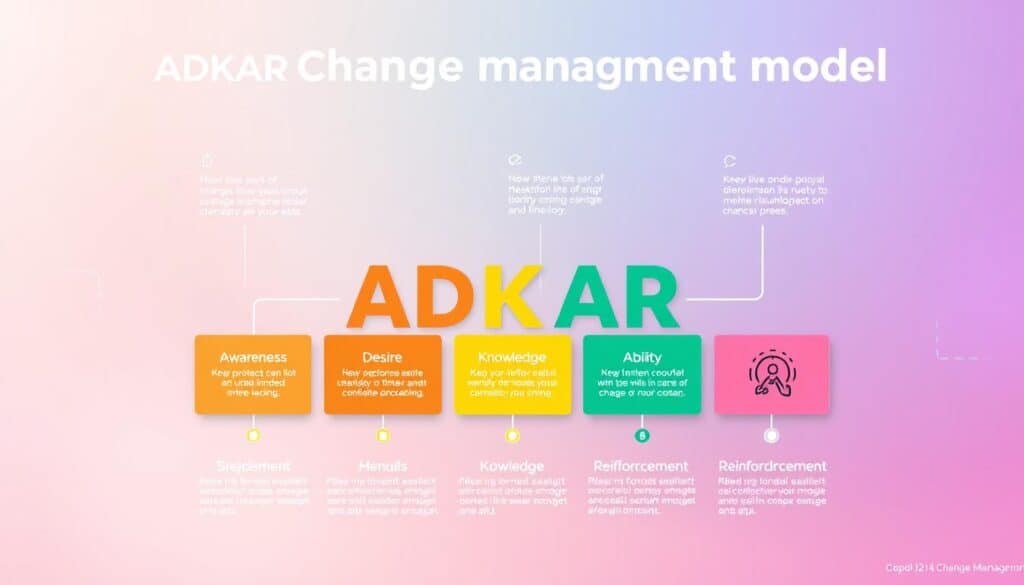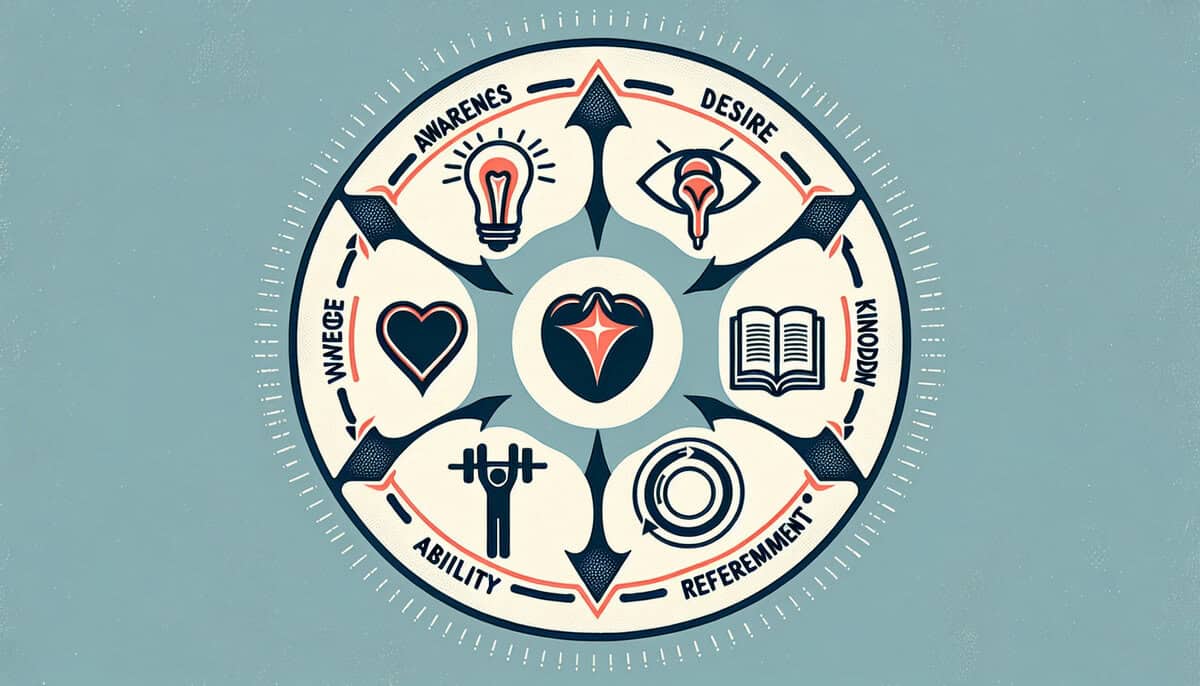Have you ever asked yourself what leads to successful personal changes? The ADKAR model was created by Jeff Hiatt of Prosci in 1996. This method focuses on the importance of managing changes one step at a time at a personal level. It has become a key strategy for leaders working through difficult changes.
Key Takeaways
- The ADKAR model includes five key elements: Awareness, Desire, Knowledge, Ability, and Reinforcement.
- Effective in diverse sectors, particularly in healthcare, finance, and technology.
- This model addresses both emotional and practical aspects of change.
- Leaders play a vital role in ADKAR model implementation and success.
- Emphasis is placed on progress tracking through metrics and key performance indicators (KPIs).
- The model encourages continuous monitoring and reinforcement post-implementation to maintain momentum.
Understanding the ADKAR Model
The ADKAR Model, made by Prosci, is a top tool for managing change. It outlines a clear path to guide people and organizations through changes. This method has five key steps: Awareness, Desire, Knowledge, Ability, and Reinforcement. They help ensure a smooth and successful change.
This model is great at handling the human aspects of change. It helps employees smoothly shift into new roles or use new technologies. This makes ADKAR useful for various changes, like tech updates or adapting to new cultures.
ADKAR is known for being flexible. It works well in any department, such as HR, IT, or Operations. It’s useful for different changes like mergers or adopting new technology. Plus, it fits any size project, from single people to the whole company.
ADKAR focuses on managing the human side of change and helping employees adapt to new processes, technologies, and roles. — Prosci
ADKAR differs from other models like Kotter’s 8-Step Process because it focuses on individuals. This reduces pushback and makes adoption quicker. One key to its success is making sure people understand why change is needed. This shows the importance of the Awareness step.
- Awareness: Understanding the need for change.
- Desire: Wanting to participate in and support change.
- Knowledge: Knowing how to change.
- Ability: Implementing the necessary skills and behaviors.
- Reinforcement: Sustaining the change.
The ADKAR Model shines by focusing on what each person goes through during change. It deals with personal challenges and what motivates people at each step. Because of this attention to detail, ADKAR works well across many industries and types of change.
Key Elements of the ADKAR Change Management Model
Each part is crucial for a successful change strategy in various fields, including USAID work and partnerships.

Awareness: Recognizing the Need for Change is essential. It’s about openly communicating the need for change, to build understanding. A study showed over 40% use ADKAR to gauge their change efforts.
Desire is about building the drive to support change. Change leaders aim to spark this desire among workers and those involved. The study found ADKAR effective, with 32% saying it’s somewhat effective and 66% finding it extremely so.
Knowledge means giving people the skills and info they need. It involves teaching tailored to everyone’s roles and responsibilities. This way, the awareness phase is strengthened by continual learning.
Ability is about applying skills and overcoming challenges. It’s crucial that everyone can put what they know into practice. Leaders note individuals reach ADKAR goals at different times, showing the personalized touch in this phase.
Lastly, Reinforcement ensures changes stick through ongoing support and encouragement. The ADKAR Model spots resistance, helping leaders to deal with it for lasting success.
All these elements lead to a organized method. This helps everyone adapt to changes effectively. By using the ADKAR Model, organizations can spot and tackle resistance, making it a strong strategy for managing change.
Implementing the ADKAR Model in Your Organization
Using the ADKAR Model can totally change how your organization handles change. It leads to big benefits. Here are key points for making the ADKAR Model work in your company:
- Leadership Advocacy: Having a leader who supports change management boosts the success of changes. Leaders need to back the ADKAR Model and create a culture open to change.
- Building Desire: Coaching is a powerful way to get people excited about change. It helps employees want to support and join in the change efforts.
- Training Programs: Joining comprehensive training, like the Prosci’s Change Management Certification Program, improves an organization’s change ability.
- Custom Methodologies: Using your own change management methods can work well. Strategies made for your company’s specific needs and culture are best.
- Mitigating Resistance: According to Prosci’s 2019 study, nearly half of employee resistance could be stopped by using good change management practices.
Here’s a table that compares key facts about successful versus unsuccessful change management:
| Factor | Excellent Change Management | Poor Change Management |
|---|---|---|
| Likelihood of Meeting Objectives | 7 times higher | Significantly lower |
| Impact of Moving from Poor to Fair Practices | Nearly triples success rate | Low success rate |
| Employee Resistance Avoidance | 47% reduced | High resistance |
| Role of Leadership | Increases success rate | Minimal impact |
Benefits of Using the ADKAR Model in Change Management
A study in 2005 with over 400 companies showed that not knowing enough caused most resistance. This fact highlights the value of the ADKAR Model’s first step.

Another key benefit of the ADKAR Model is boosting employee involvement. When people know why changes are happening and see how it matches their goals, they’re more likely to support and commit. Being actively involved reduces resistance, making things easier for all.
For any change effort, making the transition seamless is crucial. The ADKAR Model lays out clear steps and backing to guide employees. It ensures people can learn and take on new actions well. Offering ongoing training and reminders lessens issues and quickens accepting new changes.
| Factors Influencing Success | Impact |
|---|---|
| No Awareness/No Desire | Slower adoption and delays |
| No Knowledge/No Ability | Lower utilization of new processes and tools |
| No Reinforcement | Reversion to old behaviors |
It’s vital to help employees personally move through changes, too. The ADKAR Model provides clear directions for this. It looks at how people learn, what might hold them back, and what drives them. By considering these factors, the model effectively addresses the diverse challenges of change.
Tips for Successfully Applying the ADKAR Model
To use the ADKAR Model well, think it through and plan. Start by creating a strong communication plan. This helps grow employees’ desire for change and stops frustration-based resistance. If people feel part of the journey, they’re open to change.
Using social learning is key for spreading knowledge. Let peers teach each other to share insights and boost ongoing improvement.
Leadership plays a huge role too. Leaders must inspire confidence in their teams to tackle challenges. Using feedback, surveys, and tracking progress helps find...
You have read 73% of the article. The rest is for our community. Already a member? Log in
(and also to protect our original content from scraping bots)
Innovation.world community
Login or Register (100% free)
View the rest of this article and all members-only content and tools.
Only real engineers, manufacturers, designers, marketers professionals.
No bot, no hater, no spammer.
FAQ
What is the ADKAR Model in change management?
The ADKAR Model is created by Prosci. It’s a guide for handling changes through five steps: Awareness, Desire, Knowledge, Ability, and Reinforcement. This method focuses on how each person experiences change. It works well in many industries.
How does the ADKAR Model address resistance to change?
The ADKAR Model helps reduce resistance to change. It does this by considering how changes worry or scare employees. It includes employees in the change process. This makes them more likely to support the change.
What are the key elements of the ADKAR Model?
The ADKAR Model’s main points are:
- -Awareness: Realizing the need for change.
- Desire: Wanting to be part of the change.
- Knowledge: Learning how to make the change happen.
- Ability: Using what you learn to change.
- Reinforcement: Keeping the change going by encouraging it.
This approach leads to easier changes and more support from employees.
What are the benefits of using the ADKAR Model?
Using the ADKAR Model brings many benefits such as:
– Employee Engagement: Getting employees involved means they’re more likely to support the change. – Mitigating Resistance: It reduces people’s worries and fears about new things.
– Effective Training: Proper training helps employees learn and adopt new ways. – Sustained Change: Keeping up support makes sure changes last.
External Links on Social and Professional Change Management
International Standards
(hover the link to see our description of the content)
Glossary of Terms Used
Key Performance Indicator (KPI): a measurable value that demonstrates how effectively an organization is achieving key business objectives, often used to evaluate success at reaching targets.































